TRANEXAMIC ACID + KOJIC ACID
Tranexamic Acid: Tranexamic Acid is a medication that is used to prevent or reduce excessive bleeding. It is commonly prescribed for conditions such as heavy menstrual bleeding, nosebleeds, and bleeding after dental procedures or surgery.
The mechanism of action of Tranexamic Acid involves its ability to block the breakdown of blood clots. It works by inhibiting plasmin, an enzyme that dissolves blood clots. This helps to stabilize the clot and prevent further bleeding.
The dose of Tranexamic Acid can vary depending on the condition being treated. For heavy menstrual bleeding, the recommended dose is usually 1,300 mg taken three times a day for 4-5 days during the menstrual cycle. For other indications, the dosing may differ, and it is important to follow the instructions provided by the healthcare provider.
Common side effects of Tranexamic Acid include nausea, vomiting, diarrhea, abdominal pain, and headache. Some individuals may experience allergic reactions, such as itching, rash, or swelling. In rare cases, more serious side effects may occur, such as blood clots, visual disturbances, or seizures. It is important to consult with a healthcare professional if any unusual symptoms or side effects are experienced while taking Tranexamic Acid.
Tranexamic Acid should be used with caution in individuals with a history of blood clotting disorders, kidney disease, or those who are at an increased risk of blood clot formation. It is also important to inform the healthcare provider if any other medications or supplements are being taken, as they may interact with Tranexamic Acid.
Overall, Tranexamic Acid is an effective medication for preventing or reducing excessive bleeding, and its benefits outweigh the potential side effects for most individuals. However, it is important to use this medication under the guidance of a healthcare professional and to report any concerns or adverse reactions promptly.
Kojic Acid: Kojic acid is a natural substance derived from certain fungi. It is commonly used in skincare products as a skin-lightening agent and is also available in the form of creams, lotions, and soaps.
Its main use is to reduce the appearance of hyperpigmentation, such as age spots, melasma, and acne scars. It works by inhibiting the production of melanin, the pigment responsible for skin color, thereby lightening the skin tone.
The recommended dose and application method of kojic acid can vary depending on the specific product being used. It is typically applied topically to the affected areas once or twice daily, as directed by a healthcare professional or as indicated on the product packaging.
Kojic acid is generally considered safe for external use, but it may cause mild side effects in some individuals. Common side effects may include skin irritation, redness, itching, and dryness. In rare cases, it may lead to allergic reactions such as swelling, rashes, or hives. If any of these side effects occur or worsen, it is recommended to discontinue use and consult a healthcare professional.
It is important to note that kojic acid may increase skin sensitivity to sunlight. Therefore, it is advisable to use sun protection measures, such as wearing sunscreen and protective clothing, while using products containing kojic acid and avoid excessive sun exposure.
As with any skincare product, it is recommended to perform a patch test before using kojic acid to check for any adverse reactions or sensitivity. If you have any concerns or are unsure about the suitability of using kojic acid, it is best to consult a dermatologist or healthcare professional for guidance.

